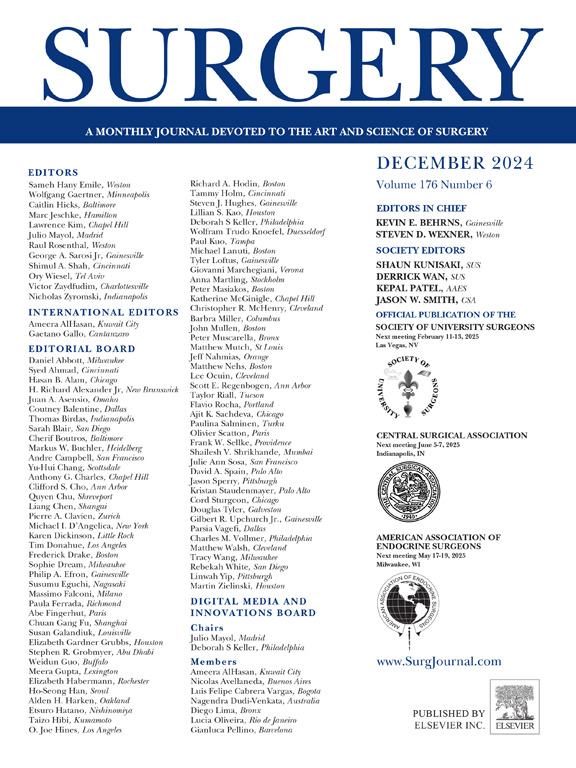虚弱与血管内胸腹动脉瘤修复结果的关系
IF 2.7
2区 医学
Q1 SURGERY
引用次数: 0
摘要
背景:鉴于老年患者血管内动脉瘤修复术的应用越来越多,准确识别虚弱患者对于优化患者选择和护理至关重要。本研究首次应用最近开发的医院衰弱风险评分,并将其与常用的外科衰弱指数进行比较,利用具有全国代表性的数据库来研究血管内腹部修复和胸椎血管内主动脉修复后的衰弱与预后之间的关系。方法在2016-2021年全国再入院数据库中确定接受选择性血管内腹腔和胸腔血管内主动脉修复术治疗未破裂主动脉瘤的成年人,并使用医院虚弱风险评分、管理风险分析指数和约翰霍普金斯调整临床组仪器将其分为非虚弱和虚弱队列。使用多变量回归模型和受试者工作特征曲线下面积来评估和比较虚弱、不良结果和资源使用之间的关联。结果在105265例接受腹腔血管内修复术的患者和16595例接受胸腔血管内主动脉修复术的患者中,10.1%和23.4%分别被医院虚弱风险评分分为虚弱。在多变量调整后,由医院衰弱风险评分确定的衰弱与死亡率和围手术期并发症(包括呼吸、肾脏和血栓栓塞事件)的增加相关。医院虚弱风险评分在预测结果方面表现出最大的歧视性、敏感性和特异性,优于包括行政风险分析指数和约翰霍普金斯调整临床组在内的模型。结论医院衰弱风险评分是一种可靠的衰弱工具,可预测易受伤害人群接受血管手术的不良后果。鉴于准确识别衰弱对优化术后护理和资源分配的关键作用,选择最合适的衰弱器械至关重要。本文章由计算机程序翻译,如有差异,请以英文原文为准。

Association of frailty with outcomes of endovascular thoracic and abdominal aneurysm repairs
Background
Given the increasing use of endovascular repair of aortic aneurysms in elderly patients, accurate identification of patients with frailty is crucial for optimizing patient selection and care. The present study represents the first application of the recently developed Hospital Frailty Risk Score and its comparison with commonly used surgical frailty indices to investigate the association between frailty and outcomes after endovascular abdominal repair and thoracic endovascular aortic repair using a nationally representative database.
Methods
Adults undergoing elective endovascular abdominal repair and thoracic endovascular aortic repair for unruptured aortic aneurysms were identified in the 2016–2021 Nationwide Readmission Database and grouped into non-Frail and Frail cohorts using the Hospital Frailty Risk Score, Administrative Risk Analysis Index, and Johns Hopkins Adjusted Clinical Groups instruments. Multivariable regression models and area under the receiver operating characteristic curve were used to assess and compare the associations between frailty, adverse outcomes, and resource use.
Results
Of an estimated 105,265 patients who underwent endovascular abdominal repair and 16,595 patients who underwent thoracic endovascular aortic repair, 10.1% and 23.4% were classified as frail by Hospital Frailty Risk Score, respectively. After multivariable adjustment, frailty identified by Hospital Frailty Risk Score was associated with increased odds of mortality and perioperative complications, including respiratory, renal, and thromboembolic events. The Hospital Frailty Risk Score demonstrated the greatest discriminatory power, sensitivity, and specificity in predicting outcomes, outperforming the models that included Administrative Risk Analysis Index and Johns Hopkins Adjusted Clinical Groups.
Conclusion
The Hospital Frailty Risk Score appears to be a reliable frailty instrument for predicting adverse outcomes in vulnerable populations undergoing vascular procedures. Given the critical role of accurately identifying frailty to optimize postoperative care and resource allocation, selecting the most appropriate frailty instrument is essential.
求助全文
通过发布文献求助,成功后即可免费获取论文全文。
去求助
来源期刊

Surgery
医学-外科
CiteScore
5.40
自引率
5.30%
发文量
687
审稿时长
64 days
期刊介绍:
For 66 years, Surgery has published practical, authoritative information about procedures, clinical advances, and major trends shaping general surgery. Each issue features original scientific contributions and clinical reports. Peer-reviewed articles cover topics in oncology, trauma, gastrointestinal, vascular, and transplantation surgery. The journal also publishes papers from the meetings of its sponsoring societies, the Society of University Surgeons, the Central Surgical Association, and the American Association of Endocrine Surgeons.
 求助内容:
求助内容: 应助结果提醒方式:
应助结果提醒方式:


